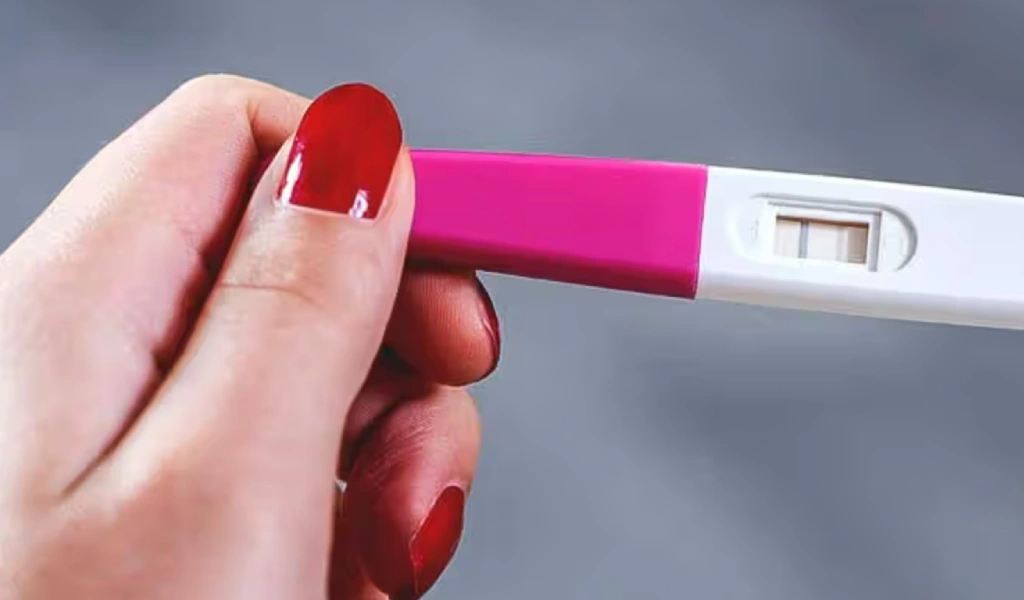Understanding the meaning of the result of faint line of the pregnancy test can assist you in determining your pregnancy status and taking appropriate action.
If you see a faint line on a home pregnancy test, you may be uncertain about whether you are pregnant. Typically, two pink lines mean pregnancy is present, while one line means it is not.
Observing a faint line on a pregnancy test may be confusing as it could indicate a range of potential outcomes. It might imply a pregnancy or even a miscarriage. However, it’s recommended not to become overly worried until rerunning the test after some days. If the results remain the same, seeking advice from a medical professional could be a wise choice.
To comprehend the information regarding home pregnancy tests, it is essential to read this article. In this article ‘What Is Faint Line On Pregnancy Test?’ we will explore the steps needed to conduct the test and the factors contributing to the presence of a faint pink line on the pregnancy kit.
Key Information About Pregnancy Tests
Let’s explore some interesting information about pregnancy tests and how they operate.
- Pregnancy tests identify a specific hormone in your blood or urine called hCG (human chorionic gonadotropin). This hormone is produced by your body when the fertilized egg implants in the uterine wall.1
- Two primary kinds of pregnancy tests are widely used: blood tests and urine tests, also known as home tests. The quantitative blood test is more precise and quicker in detecting early pregnancy than qualitative blood or urine tests.2
- The majority of at-home pregnancy tests work by examining a sample of your urine to identify the hormone hCG. When a line appears on the indicator panel after a few minutes, it indicates a positive pregnancy.3
- If the line is faint in early pregnancy, you can retake the test after a few weeks.
- Home pregnancy tests are generally reliable. Certain pregnancy test kits may be more sensitive than others.
- A highly accurate home pregnancy test can detect early signs of pregnancy, including on the first day of a missed period.4
- A pregnancy test may sometimes show a false negative outcome even if the woman is truly pregnant. It is advisable to wait for a week and retest in such situations. The accuracy of the test may be impacted by the use of particular medications or alcohol, leading to an inaccurate negative result.
- Before using the home pregnancy test kit on your own, make sure to thoroughly read the test instructions.
- It is best to take a pregnancy test in the morning as urine is more concentrated and hCG hormone levels are typically higher at that time.
- Testing immediately after a missed period can result in inaccurate negative test results. Research has shown that the majority of women, 9 out of 15, may receive false negative pregnancy tests until they are between seven to eight weeks pregnant.5
- Every home pregnancy test includes a display box with a color line to confirm if the test is functioning correctly. A second color line will show up if the test detects the hCG hormone in urine. Even if the line is faint, it is still viewed as a positive indication.
- It is recommended to repeat the test after two to three days following a consultation with your gynecologist, as a faint line could also indicate an ectopic pregnancy.6
- If your pregnancy test comes back positive, schedule an appointment with your gynecologist to receive the necessary guidance.
Reasons to use a home pregnancy test
There are many advantages to using a home pregnancy test.
- The pregnancy test kit examines the hormone hCG level in your urine, allowing you to anticipate the status of your pregnancy ahead of time.
- When you are trying to get pregnant, it’s not convenient to constantly go to the doctor to check if you are pregnant. Home pregnancy test kits make it easy to detect hormone levels in your urine.
- The at-home pregnancy test kit enables women to take the test for pregnancy in the privacy and comfort of their own homes.
- The ideal moment to do a pregnancy test is early in the morning when hormone levels are at their peak.
- One of the main advantages of the pregnancy test is how quickly it provides results. The outcome is shown on the kit within a timeframe of under three minutes.
How to Conduct a Pregnancy Test at Home
All pregnancy tests are essentially identical, with the only variation between brands being the sensitivity of the test kit. Now, we will go through the specific instructions for performing a home pregnancy test.
- The home pregnancy test kit comes in two different designs. One design includes a strip, while the other design includes a container for collecting urine.
- Either pass urine directly onto the strip or immerse the tip of the strip into a container of urine.
- Follow the manufacturer’s instructions and wait a few minutes before checking the results.
- The length of time you have to wait for the outcome is entirely based on the directions given in the testing kit.
- When two distinct lines are visible on the display panel, it signifies a positive outcome. However, if the second line is faint, it suggests an uncertain result, and it is advised to retake the test after a few days for confirmation.
Understanding Faint Line On A Pregnancy Test
A faint line on a pregnancy test suggests a low level of the hormone (hCG) in the urine. The line may be faint due to either a low or very high concentration of the hCG hormone, such as in an ectopic pregnancy. The hormone hCG is typically found in the urine when a fertilized egg implants in the uterus.
However, during early pregnancy, the hormone level is often too low for detection by a home pregnancy test. As a result, a faint line may appear on the test.
Reasons To See Faint Line On Pregnancy Test
There are several explanations as to why home pregnancy tests may display faint lines rather than strong ones. Next, we will explore some common reasons for observing a faint pregnancy line.
- When the directions on the pregnancy test kit are not followed correctly, the results may be inaccurate.
- If you fail to give enough time for the test to develop and check the results too soon, faint lines may appear. It is crucial to wait for the designated time before examining the results on the display screen.
- Reviewing the test results too early or late may cause evaporation lines to appear, typically faint and pale in color.
Testing Too Early
- Detecting a positive result on a pregnancy test very early after conception is a common occurrence that often results in faint lines being seen.
- The home pregnancy test identifies the presence of the hCG hormone in your urine and interprets the results. hCG levels are minimal and hard to detect in the early stages of pregnancy. The appearance of a faint line on the test indicates a low concentration of hCG detected by the kit.
- The ideal time to take a pregnancy test is at least ten days after ovulation or one week after missing your period. This timing allows for accurate detection of the hormone using a home pregnancy test kit.
Anne, who has three children, looks back on the moment she saw a faint line on her pregnancy test. She was impatient and tested too early out of eagerness. She acknowledges that it was about four days before her expected period, but she couldn’t resist taking the test due to her anxious nature. A very faint line appeared after 4 minutes, leading to her taking a test almost every day for the following two weeks and then 2-3 times a week after that. She insists that she is not crazy, just extremely anxious about the situation.
Miscalculating Your Expected Period
- You might inaccurately predict your menstrual cycle and take the test on the wrong days, resulting in faint lines on the pregnancy test.
- Keeping track of both your basal body temperature (BBT) chart and menstrual cycle is recommended. This can help in remembering important dates and reducing any misunderstandings.
Diluted Urine
- It is recommended to take the home pregnancy test in the morning when the concentration of hCG hormone is higher, making it easier to detect in the urine.
- Conducting the test at different times results in the urine being more diluted and having a lower concentration of hCG hormone. In this case, the test kit may not accurately detect the hormone, causing the test line to appear faint.
Pregnancy Test Sensitivity
- Some of the pregnancy testing kits seem to be more sensitive compared to others.
- Some home pregnancy tests can identify pregnancy with a low hCG level of 20 mIU.
- Some other pregnancy tests need a minimum level of 100 mIU of the hCG hormone to determine if a woman is pregnant.
- Therefore, more sensitive pregnancy tests will display darker lines, while those that are less sensitive will show lighter lines.
- A high level of hCG, such as in the case of an ectopic pregnancy, could be mistaken for a faint line on a pregnancy test along with symptoms like abdominal pain and spotting.
Expired Pregnancy Test
- Make sure to always examine both the expiration date and storage instructions provided on the pregnancy test kit.
- Using an expired or improperly stored pregnancy test kit can lead to inaccurate results and the test not working properly.
Evaporation Lines
- When your urine dries up on the pregnancy test, the line will be faint and difficult to see clearly.
- The faint line shows up in the location where the positive outcome is usually displayed, signifying a positive pregnancy status.
- Evaporation lines can be difficult to see with the naked eye and may look like a faint shadow.
Reading Test Results After Manufacturer’s Recommended Time
- If you do not check the test results within the time frame advised by the manufacturer, you might notice a barely visible line.
- The home pregnancy test is highly sensitive and the result only lasts for a brief moment.
- It is recommended to check the test results within the specified period to accurately determine the pregnancy status.
Chemical Reaction
- Our body produces the hCG hormone as a result of specific chemical reactions; however, this hormone does not lead to a normal pregnancy.
- In the body, a chemical reaction takes place indicating an early miscarriage, causing faint lines to appear on the test.
- Pregnancies that experience complications and miscarriages often have lower levels of hCG than expected. If a faint line on a pregnancy test later turns out to be negative, it could indicate a chemical pregnancy. About 40% of cases of chemical pregnancy result in miscarriage.
Certain Medications
- The use of certain medications like Thorazine or fertility drugs can lead to the detection of hCG hormones in your system.
- The faint lines that appear on the home pregnancy test are a result of a false positive caused by the presence of the hCG hormone in your urine.
Can the presence of a faint line on a pregnancy test indicate a positive result for pregnancy?
Home pregnancy tests show a positive result when they can detect the hCG hormone in your urine. The sensitivity of these tests varies greatly among different brands. A highly sensitive test can detect pregnancy even at low levels of hCG, while less sensitive tests may only show a positive result when hormone levels reach a certain point.
Dr. Flisser asserts that the purpose of home pregnancy tests is to provide qualitative results by detecting the presence of the pregnancy hormone, rather than measuring its exact levels. In essence, these tests offer a simple yes or no answer. The main goal of the test is to specifically confirm the presence of the pregnancy hormone (hCG) in urine, yielding a positive result only if a pregnancy is detected.
However, a faint line on a pregnancy test does not necessarily mean you are pregnant; instead, it could indicate an early miscarriage. If you see a faint line on the test, don’t panic. It is recommended to wait for two to three days and then take the test again for more reliable results.
A positive pregnancy will typically result in a darker line after a few days. If the line continues to be faint in multiple tests, it is important to seek immediate medical advice from a gynecologist.
Follow The Mentioned Steps When A Faint Line Appears On Pregnancy Test
Many women have the desire to confirm their pregnancy soon after conceiving. They are eager to know the result but testing too early can result in a faint line on the pregnancy test. Here are a few steps to take when you see a faint line on a pregnancy test:
- If the line on the pregnancy test is faint, it is recommended to wait a few days for the hCG levels to rise and for a more accurate result to show a bold line indicating a positive pregnancy.
- When undergoing new tests- If the line is faint on a home pregnancy test, consider taking another test. You may want to try a different brand of pregnancy test kit that has higher sensitivity to detect the hCG hormone more easily, which will show a clearer positive result.
A subtle line on the pregnancy test might indicate low levels of the human chorionic gonadotropin (hCG) hormone. This is typically seen in the initial stages of pregnancy when hCG levels are minimal in the urine. Despite being faint, a line is still viewed as a positive indication, and you could consider redoing the test with first-morning urine after a couple of days.
If you notice a faint line, it is advisable to consult a gynecologist as certain medical issues like ectopic pregnancy can lead to low hCG levels and faint lines on at-home pregnancy tests.
Key Pointers of ‘What Is the Faint Line On Pregnancy Test?’
- Two lines on a pregnancy test confirm a positive result, whereas a single line signifies the absence of pregnancy. A faint line on the test may cause uncertainty, hinting at the potential for either pregnancy or miscarriage.
- Pregnancy tests operate by identifying the presence of the hCG hormone, which is generated by the body following the attachment of the fertilized egg to the lining of the uterus.
- There are two primary forms of pregnancy tests: blood tests and urine tests, with the latter typically being carried out in the comfort of one’s own home.
- If you see a faint line or a negative result on a pregnancy test, wait for a week and take the test again.
- It is recommended to do the pregnancy test in the morning when the urine is concentrated and the level of hCG is high.
- A faint line on the pregnancy test typically suggests a low level of hCG hormone in the urine, possibly due to not following instructions properly. Testing too soon in the pregnancy could also result in a faint line. Diluted urine can also play a role in this.
- Pregnancy tests differ in their level of sensitivity, which may be a factor in the appearance of faint lines.
- The use of an expired kit could also result in faint lines on the test. Additionally, certain medications could potentially interfere with the accuracy of a pregnancy test.




























